
Editor’s note: Every 10 years for the past four decades, the Association of Theological Schools in the United States and Canada (ATS) has provided data for a major study of revenue trends in theological education. Now the Center for the Study of Theological Education at Auburn Theological Seminary has published the fifth study in the series, by Anthony Ruger and Chris A. Meinzer, titled Through Toil and Tribulation: Financing Theological Education 2001–2011. The document is available with full text, tables, and charts at www.auburnseminary.org/research-on-theological-education#financing.
The excerpts on these pages focus on tuition and financial aid and the impact of escalating expenses at ATS schools, and the research team used data supplied by the Commission on Accrediting of the ATS. The full report includes much more, including data on enrollment, investments and spending rates, gifts, and grants. Also included in the full report: Endnotes that support the claims made here.
The decade of 2001 to 2011 was another lean period for North American theological education. The Great Recession negatively affected investments and gifts. Levels of formal religious affiliation declined, undermining church support of theological schools and student enrollment. But here’s a spoiler alert: As documented by our research, not all the news is bad. Despite the undertow of a poor economy and changing religious environment, some schools managed to strengthen their financial undergirding and capacity for mission. In the hope that the best practices of these “success schools” might benefit other institutions, we interviewed the leaders of six of the schools and included their insights in the final section of this report. Stay tuned.
To put the good news into perspective, we first will summarize three challenging trends that all schools faced — a hike in tuition, a dip in discounts, and the effect of inflation and constant expenses on small-scale institutions.
Tuition up, discounts down
Tuition rates for the master of divinity (M.Div.) degree have risen steadily for the past 20 years. As Table 1 shows, average tuition charges increased between 4.5 and 5.5 percent each year from 2001 to 2011, and so a 2011 student paid an average of 57 to 68 percent more than a 2001 student. When we take inflation into account, the increase is 20 to 40 percent, depending on the index used.

Over a 20-year period, the surge is even more striking. Students in 2011 paid an average of 150 to 200 percent more in tuition than their counterparts in 1991; in real (inflation-adjusted) terms, they paid between 88 and 139 percent more.
Despite these increases, theological school tuition is modest. Average M.Div. tuition is substantially less than the average undergraduate tuition at a private institution. Low comparative tuition rates, however, don’t always mean that students comfortably bear increased costs. Debt from undergraduate education, plus amounts incurred during seminary, are putting greater stress on recent graduates.
Financial aid grants, called “discounts,” enable students to defray some of their tuition and living expenses. But the 10-year trend lines shown in Figure 1 indicate that grants cover a slightly smaller proportion of tuition than they did at the beginning of the decade. Table 2 shows discount rate data for schools according to their broad ecclesial tradition. (Roman Catholic schools are difficult to compare to others because candidates for ordination often are supported by their diocese, or religious order, and are not included in the data on master’s level discount rates.)
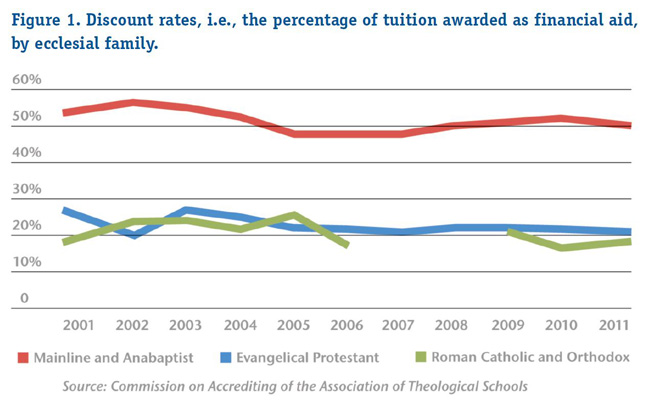
Even though the aggregate discount rate is declining, variations are enormous in the amounts of financial aid that individual schools provide. As Table 2 shows, the discount rate for master’s degree students ranges from nearly nothing (meaning students pay the full tuition rate) to rates of over 100 percent, signifying that some schools provide more in financial aid grants than they bill in tuition. In those instances, students have extra funds to defray the cost of fees, books, and living expenses.
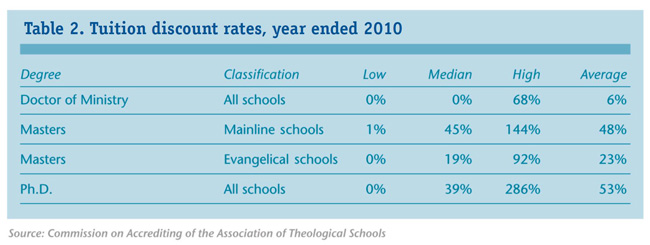
We often hear about students enrolling in particular schools because of generous financial aid offers. Yet the range in discount rates raises questions about the effectiveness of discounting as a strategy for attracting students. The net price students pay varies greatly among schools in the same ecclesial tradition and even among schools in the same denomination. Nevertheless, schools with low discount rates manage to attract their share of students. Some may attract more than their share due to a superior reputation and adept marketing. Or, prospective students may be uninformed about actual costs because discount rates often are not published. No comparative “net price list” is available to consult.
Different programs offer different levels of financial aid as well. Doctor of ministry (D.Min.) students typically receive modest levels of grants, if any; those students are usually in full-time paid ministry, and are likely to have lower school-related expenses. By contrast, full-time master’s degree students have greater need. Grants to students in elite, competitive Ph.D. programs can be very high.
Our research confirmed two trends. First, tuition rates, even after the application of financial aid grants, continue to outpace inflation. Second, student indebtedness continues to rise. These factors can lead to uncertainty about the manageability of increasing debt and contribute to students’ reluctance to consider theological education and ministry.
Expenditures vs. inflation
Predictably, theological schools cut their expenditures in response to the recession that began in 2008. Figure 2 shows a 10 percent reduction in expenses from 2008 to 2010 for all reporting schools. For the entire 2001–11 decade, the schools’ expenditures did not keep up with inflation. Schools spent 3.4 percent less in 2011 than in 2001, when inflation is taken into account. Much of the belt tightening after 2008 was painful and involved compensation cutbacks, reductions in force, retirement buyouts, and no-frills cost discipline.
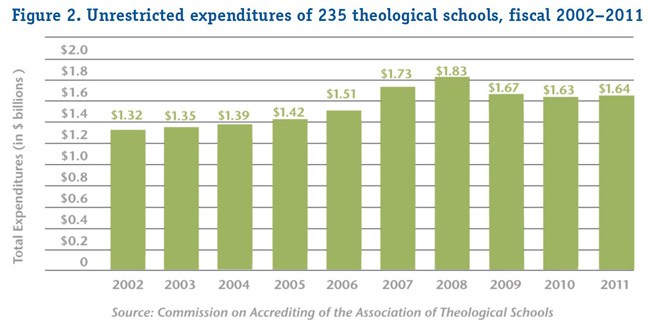
Expenditure reductions are particularly challenging for theological schools because they have a high proportion of fixed costs that are hard to reduce. Buildings require maintenance, administrative functions are (mostly) necessary, and faculty contracts are multiyear. The challenge is even greater for small schools, and the majority of theological schools are very small. (Head count enrollment for each of the 257 ATS schools is shown in Figure 3. The 64 largest institutions enroll 65 percent of the students, while the other 193 schools enroll the other 35 percent.) As Figure 4 shows, the quartile of schools with the least enrollment had an average per-student cost in 2011 that was 90 percent higher than the quartile of schools with the largest enrollment.
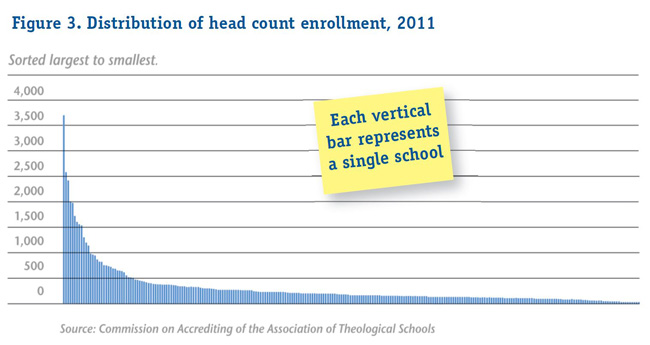
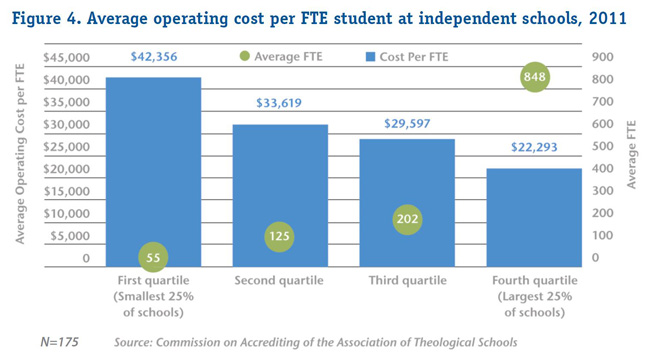
Are small schools inefficient? Yes, because fixed costs are spread over fewer students. Is efficiency the only criterion when assessing the viability of the school or formulating a strategic plan? Many might say there should be multiple criteria. The mission of the school to educate leaders, engage in research, do service, and preserve and enhance the school’s theological tradition are significant factors. Nevertheless, a small school faced with declining enrollment and financial losses ought to seek an affordable, sustainable future. Insofar as these ongoing challenges are not likely to change dramatically in the future, stewardship of the mission may necessitate reimagining the institutional form that carries the mission.
In addition to operating expenditures, many schools bear responsibility for capital renewal: the repair and replacement of major building systems and components such as heating, air conditioning, elevators, roofs, and equipment. Under financial pressure, many schools defer maintenance, postponing regular and sometimes even pressing repairs to buildings and equipment. Each year the ATS asks its member schools to estimate their cost of deferred maintenance. Figure 5 shows the reported deferred maintenance estimates for 50 schools that performed professional surveys of their facilities. The range is huge, from over $30 million to zero. Institutions use different methods to arrive at their estimates, so the figures are not strictly comparable. Still, the median reported amount of deferred maintenance was over $2.1 million, and the average was more than $4.8 million. These are substantial amounts.
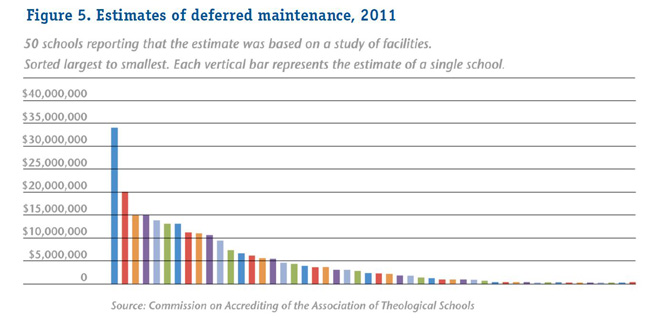
Results and dynamics of success
A number of theological schools, large and small, ended the decade with significant operating deficits. Thirty-seven percent of the freestanding schools ended the year with surpluses. Another 20 percent had deficits under $250,000 — a potentially manageable amount, depending on the size of the school. Seventeen percent had deficits over $1 million.
Our study had a special focus on the 20 schools that strengthened their net assets by 40 percent or more over the course of the decade. They ended the decade about 13 percent stronger when 27 percent inflation is taken into account. This is a remarkable achievement when enrollment, investment markets, and gifts were wobbly. Table 3 shows some of their methods for success. The methods were used singly or in combination, which is why the “Number of Schools” column in the table adds up to more than 20. Some of the methods — the sale of property or a merger — are rare or singular occurrences. Therefore, as researchers, we concentrated on ongoing operating best practices. We revisited six schools that showed steady financial progress, despite occasional hiccups, during the decade. The schools varied in size, theological posture, and church affiliation. We asked chief executives, chief financial officers, chief development officers, chief academic officers, board members, and others how their schools achieved financial success. Answers were consistent: Conquering a deficit and sustaining a balanced budget required significant, coordinated, committed effort.
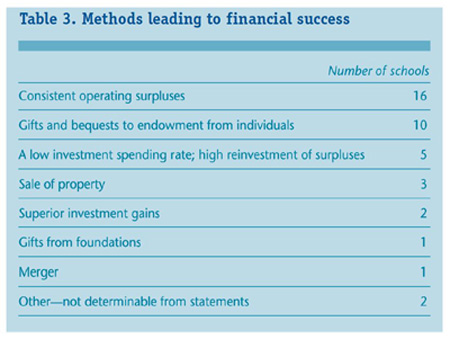
The comments that follow reflect a composite of the six schools. No individual school claimed to be exemplary, but all had four characteristics in common.
1. Conviction
The leadership of financially successful schools shared a conviction that deficits are unacceptable and toxic. Several schools went through a crisis when trying to balance their budgets. Two schools’ new presidents inherited a habit of deficit budgeting. Other schools were temporarily thrown by the investment market meltdown or other unforeseen event. At some point, a resolve to eliminate the deficit took hold. The effort was so stressful on the administration and board that they agreed to avoid all future deficits.
2. Teamwork
Successful schools exhibited a willingness to collaborate. As one leader commented, “We got all the voices around the table, like a ‘team of rivals.’ The other administrators helped to stimulate the president’s courage. The board was provided the information and made the decisions. The board chair took the heat.”
The phrase “the board was provided the information” carries significance. The team had to learn how to provide information in a thorough yet useful way to inspire appropriate board action. Transparency about the nature and extent of the crisis was a crucial step in unleashing the energy, attention, and commitment of their boards. After balancing the budget, some schools restructured and energized their board committees. One school characterized its highly engaged board committees as “communities of strategy” for the president and senior officers.
3. Development
Consistent balanced budgets — both operating and capital budgets — provided the foundation for strengthening the schools through fundraising. Put simply by one president: “Donors don’t want to fill your hole. They want to build a mountain.” There are exceptions — donors so loyal or moved by a school in difficulty that they give generously despite deficits. Those stories are rare, and “crisis” appeals can’t be repeated often. Fundraising literature and consultants agree that major donors want assurances that the organization is well run and their gifts are well used. One president stated, “People need to trust what you have done with their money.” Each of the successful schools built on their balanced budgets and board-administration partnerships through steady and patient attention to the task of development.
4. Vision
Schools often must shelve interesting educational and administrative initiatives for lack of funding. Worse, some staff or faculty may be “looking over their shoulder,” concerned that their programs, compensation, or jobs are at risk. Sometimes complaints of overwork, turnover of staff, resistance to change, and office politics are symptoms related to a lack of institutional confidence. Few organizations are free of these behaviors, but positive counterweights were evident in the successful schools.
One school talked about a 40-year strategic plan. Another school topped that with a 100-year plan. These claims are surprising. Most three-year strategic plans are out of date in 18 months. How could any institution plan so far in advance?
The 40- and 100-year plans were not “plans” in any conventional sense. They were statements of the school’s values and vision. Put another way, the “plans” were the translation of the mission into the corporate, shared vocation of the school. This shared vocation contributed to the cooperative governance the schools showed, and seemed to animate and motivate the persons associated with the school. The positive yet realistic attitude was palpable in our interviews. The undertow and shadows that deficits can cause seemed to be absent.
A virtuous circle
Each of the “best practices” leads to and supports the others. If a school with persistent deficits wished to tackle its problem, it would likely start by increasing the collaboration and effort of the administrative team. For that energized administration to make serious headway, the board would have to be up to speed, engaged, and energized in the task of sustaining an adequate and financially viable mission. An engaged and energetic board would recognize the importance of making friends and fundraising, including strengthening the board membership. Effective fundraising and governance, in turn, foster a common vision and vocation among all who care about the mission of the school and the future of the church. None of the best practices is “best” if attempted in isolation, or pursued without attention to the others. These practices together create a virtuous circle, which can lift the entire school.
The full-length version of this report is available at www.auburnseminary.org/research-on-theological-education#financing.
=====
Addressing the challenges of a sample school
To illustrate the challenges documented in their Auburn Studies report, researchers Anthony Ruger and Chris A. Meinzer created a hypothetical institution—Emmett Theological Seminary—that is a composite of several ATS schools. Here they propose action steps to address Emmett’s challenges.
Emmett Theological Seminary is in serious financial trouble. Its once-thriving residential master of divinity program has diminished significantly. Classrooms and student housing are only partially filled. Facilities are aging. Denominational funding for operating support has trailed off and individual donations have not made up the difference. The seminary had to borrow funds to construct a new office building because capital gifts were insufficient. The interest expense caused the deficit to swell. The overspent endowment took a nosedive when the Great Recession arrived. What steps should school leaders take?
Emmett’s leadership should start with several clear-eyed quantitative and qualitative analyses. Ask: What are the actual enrollment numbers? What are the demographic, geographic, and vocational characteristics of the students who enroll? How does Emmett compare to its competition in size, convenience, offerings, and cost? Why do students choose Emmett? What does the seminary think its distinctive competitive advantages are? Do enrolled students cite these distinctive strengths?
Why do some applicants who are accepted fail to enroll, or decide to attend different theological schools?
Financial analyses and projections are the next steps. The basic question Emmett must address is: How far are we from financial stability and growth in the intermediate and long term? What numbers (operating surpluses, net financial capital growth) must we hit to sustain our mission? The projections might show that “business as usual” means that reduced net tuition and declining denominational support will exacerbate the operating deficit, overspending from endowment will continue to weaken the financial net assets, and neglected buildings will eventually take their revenge. Significant future challenges loom and require effective and immediate action.
The quantitative financial projections should give rise to some qualitative imagining. “What if” scenarios will help leaders explore possible changes and the likely results of those changes. What should Emmett’s future programs look like? Should it downsize? Can it expand to attract new constituents? What does it mean to focus on its singular contribution to the church and world? All suggestions and scenarios should be welcomed. Skepticism about easy answers — “we’ll go online” or “we’ll raise lots of money” — is essential, especially if Emmett has little experience in developing and marketing online programs or cultivating prospective donors.
Analyses and projections promote effective administrative teamwork and often result in a more empowered and visionary board. The analyses and projections are the meat in the crucial task of finding a viable future. If the work shows that business as usual is not sustainable, it will also probably show that no easy answers or quick fixes exist. The alternatives that many schools are contemplating — transforming educational delivery, seeking new or renewed constituencies, asset sales, institutional reconfigurations, mergers — are difficult and raise deep questions about a school's identity, autonomy, mission, and vocation. The way forward calls for financial discipline and program creativity, in addition to the thorough, thoughtful collaboration of the board, administration, faculty, and the religious communities that Emmett serves.